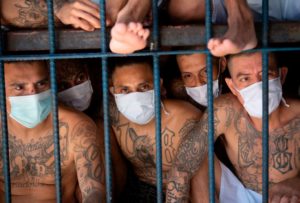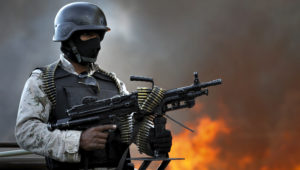It is no big secret that Mexican police officers moonlight for drug traffickers. As far back as 2010, a state commander nicknamed “El Tyson” admitted in a confession video on national television that he was not only a high-ranking cartel member, but that he made young narco recruits cut up bodies to lose their fear of blood. El Tyson was arrested by the federal police when it was controlled by Genaro García Luna, a square-jawed intelligence agent who was a key architect of the country’s war on cartels.
In a twist of fate, however, García Luna is now himself on trial in New York, accused of pocketing millions of dollars from those same kingpins after helping them traffic tons of cocaine to America. The trial, which began on 17 January in a federal court in Brooklyn and is expected to last eight weeks, breaks new ground in the drug war. Since Richard Nixon first declared a war on drugs in 1971, the US has taken down a vast array of Mexican traffickers — most famously Joaquín “El Chapo” Guzmán, who was convicted in the same Brooklyn courthouse in 2019. But never before has such a high-ranking Mexican official faced a US jury on drug charges.
Journalists and activists have for years pointed out that it is no use targeting the mobsters if you don’t go after their political protection. This case therefore marks a serious turning point for US law enforcement. But it also rings alarm bells. The level of corruption alleged by the witnesses goes beyond anything I’ve seen in my two decades covering Mexico’s drug war. At the very least, the trial is deeply embarrassing for Washington’s drug agents and politicians who schmoozed with García Luna. (There are photos of him with Hillary Clinton, Barack Obama and former Attorney General Eric Holder.) More seriously, the far-reaching allegations also suggest that, unless the United States can reduce the amount that Americans spend on illegal drugs — estimated at close to $150 billion a year in one study — this narco corruption may just carry on with catastrophic consequences.
What’s more, it is by no means guaranteed that the jury will convict García Luna. In his opening argument, defence lawyer César de Castro claimed the prosecution does not have hard evidence that his client led a double life as law enforcer and crime boss. “No money. No photos. No videos. No texts. No emails. No records,” De Castro said. “No credible, believable, plausible evidence Mr García Luna helped the cartels.”
Prosecutors are, however, using the testimony of so-called cooperating witnesses, including scarred and grizzly cartel operatives who could have made deals with prosecutors to take the stand. Some have confessed to killing multiple victims and were major traffickers. Before the trial started, the judge even had to rule that the defence could not ask them about potential acts of cannibalism — a practice that various gangsters have been found to engage in — because it might be “distracting”.
As the jury was selected, prosecutors rigorously made sure the candidates agreed they could believe such witnesses and convict someone on their evidence, even if it were not backed up by physical proof. If the jury were to find García Luna not guilty, it would be, as Mexican President Andrés Manuel López Obrador said on Tuesday, “a fiasco — the agencies and government of the United States would look very bad”. There is a lot at stake.
When I met García Luna back in 2005, when he was a rising star as the head of a federal investigative agency dubbed as Mexico’s FBI, he struck me as underwhelming, largely because he mumbled and stuttered. But he was convincing in his argument that Mexican law enforcement had to change to meet the new challenges. This was a time when gangland murders in Mexico were on the rise and Mexican traffickers had usurped Colombians as the biggest gangsters on the continent, smuggling the lion’s share of cocaine, heroin and crystal meth over the Rio Grande.
The following year, García Luna rose to a cabinet-level role under President Calderón, who ordered soldiers and police on a national offensive against the cartels. García Luna revolutionised the federal police, increasing it from a force of 6,000 to 37,000 officers. He also tried to salvage its image, financing a TV soap opera called El Equipo, in which good-looking cops went on daring operations. Moreover, Calderón crafted the Merida Initiative with Washington to increase cooperation in the fight. Under it, the United States provided Mexican law enforcement with billions of dollars in equipment and training, including Black Hawk helicopters and wiretap gear. García Luna also forged strong relationships with agents from across the US security apparatus.
At first, this new war on cartels appeared to bear fruit. In 2007, Mexican marines made the world’s biggest ever cocaine bust, a seizure of 23 tons off the Pacific coast. Kingpins who had long evaded justice were shot dead. Detained cartel suspects were made to record confession videos, like that of Tyson, in which they detailed serial murders.
But then violence erupted, with relentless firefights, execution-style hits and massacres. I covered much of this bloodshed — a grim period spent discovering bullet-ridden corpses on the street and watching too many mothers screaming in grief. By the time President Calderón left office in 2012, Mexico was suffering from a humanitarian crisis of mass graves and disappearances that remain unsolved. For his part, García Luna left Mexico for Florida to set up a security consulting company and rent a luxury beach house.
Seeing García Luna in the first days of the trial, he cut a transformed figure, silver-haired and beaten down by prison, where he has been since his 2019 arrest. Yet he also looked calm and alert to all the technicalities of the trial, occasionally smirking and blowing kisses to his wife. The first government witness was Sergio Villarreal Barragán, a hulking enforcer known as El Grande, a former police officer who was recruited by the Sinaloa Cartel. The fact that Villarreal was in the police before the mob is not a freak occurrence, but revealing of Mexico’s history: the country’s cartels grew from their humble beginnings as peasant farmers with the help of corrupt networks in the security forces. The career path between gangsters and police officers was like a revolving door.
Villarreal described seeing his boss, the kingpin Arturo “The Beard” Beltrán Leyva, meet García Luna in a safe house in the south of Mexico City and hand over bribe payments in duffel bags and cardboard boxes — worth more than a million dollars a month — on behalf of the Sinaloa Cartel. In return, García Luna allowed the cartel’s cocaine to travel through Mexico, busted its rivals and passed on police intelligence. “Everything ran perfectly. It was the best investment they made,” he said. One time, the cartel used this intelligence to steal two tons of cocaine from rivals, Villarreal testified, and split the profits with García Luna himself.
Such testimony was expected in this trial. But what Villarreal then described was remarkable. The cartel, he explained, would make false cocaine bricks and swap them with police for real cocaine that had been seized. Another time, the mobsters dressed up as police, arrested a rival and then handed him over to the real officers. On one occasion, the cartel kidnapped García Luna and brought him before The Beard because he wasn’t answering the telephone.
Villarreal also explained how the cartel’s close relationship with corrupt police actually succeeded in reducing Mexico’s murder rate for a period in 2007, just when Calderon’s offensive seemed to be going well. But then, he said, the deals inside the cartels fell apart and the violence soared. One of the biggest battles was between Beltrán Leyva and his childhood friend “El Chapo”, which ended with Beltrá Leyva being gunned down by Mexican marines.
In 2019, I covered a stretch of El Chapo’s trial, which was more enthusiastically embraced by the New York media. Everyone wanted to be in the courtroom and see such an infamous mobster and his beauty-queen wife in the gallery. US cable networks ran regular segments on the trial’s revelations, whether it was El Chapo running through a tunnel naked to escape marines or his former lover taking the stand and crying while his wife chuckled. García Luna’s trial, by contrast, has garnered far less attention. But in some ways, the revelations are more important in showing how corrupted Mexico’s institutions are and why the country is so violent.
The trial might act as a deterrent to make Mexican officials think twice before blatantly taking cartel bribes. Mexican President López Obrador certainly looks upbeat when he talks about it in his morning press conferences, saying it shows how corrupt the previous administration was. Yet the trial also symbolises something uncomfortable about modern-day Mexico. It is notable, for instance, that the trial is in New York not Mexico City. Mexican judges have convicted generals and state governors for working with drug gangs, but not an official as powerful as García Luna — or a former president. And as long as the country’s security forces find more sophisticated ways of taking bribes, such as using intermediaries, this looks unlikely to change. Perhaps even more depressing is the fact that since García Luna has gone, the cartels have shifted to more perilous synthetic drugs such as fentanyl, which are driving a far worse rate of overdoses in the United States.
Everything has changed since, and not necessarily for the better. In his testimony, El Grande also talked about the glitter of narco wealth; how his boss The Beard had a fleet of cars, including a Lamborghini, a Ferrari, and a Rolls Royce, and pets including a white tiger and black panther. Amid such opulence, achieving justice for the deaths on both sides of the border will be an extraordinary, if impossible, challenge. While the stories of El Grande, The Beard, and El Chapo may dominate the headlines, they are far removed from the bloody conflict that has consumed Mexico — and the decaying corpses still being dug up in mass graves.
Disclaimer
Some of the posts we share are controversial and we do not necessarily agree with them in the whole extend. Sometimes we agree with the content or part of it but we do not agree with the narration or language. Nevertheless we find them somehow interesting, valuable and/or informative or we share them, because we strongly believe in freedom of speech, free press and journalism. We strongly encourage you to have a critical approach to all the content, do your own research and analysis to build your own opinion.
We would be glad to have your feedback.
Source: UnHerd Read the original article here: https://unherd.com/



